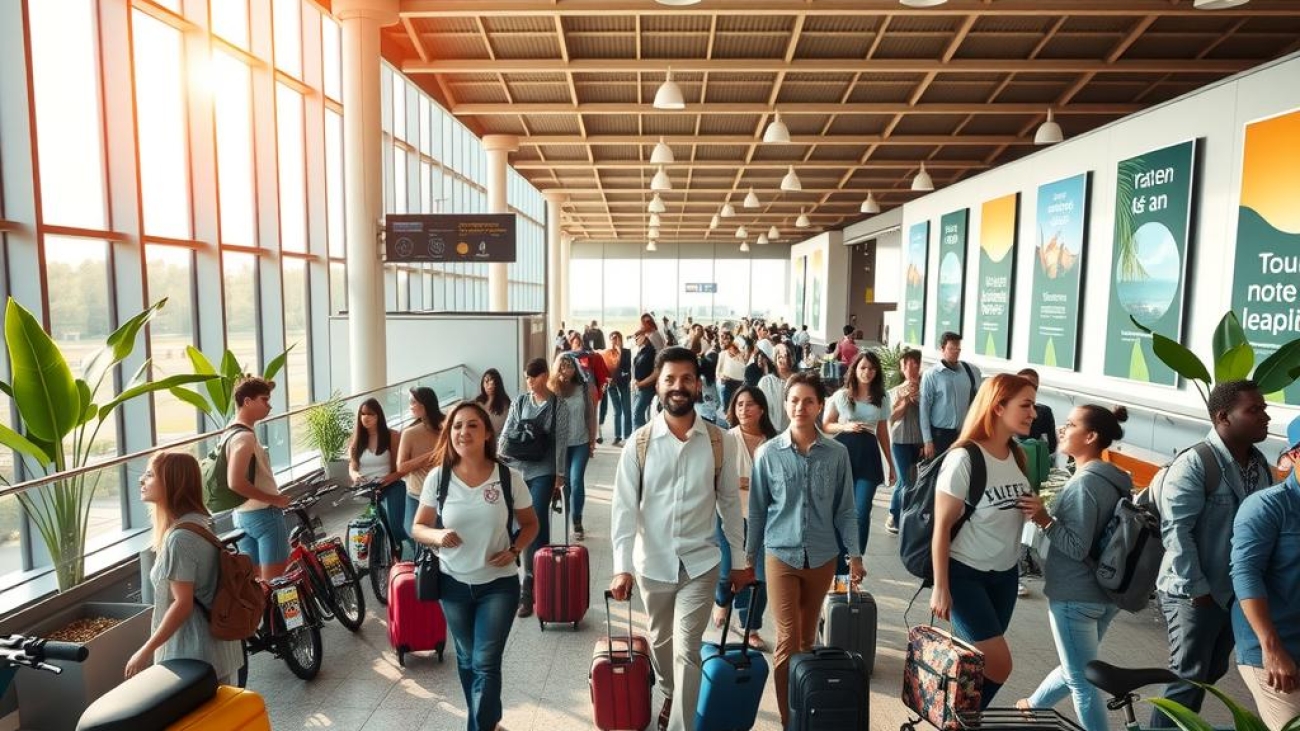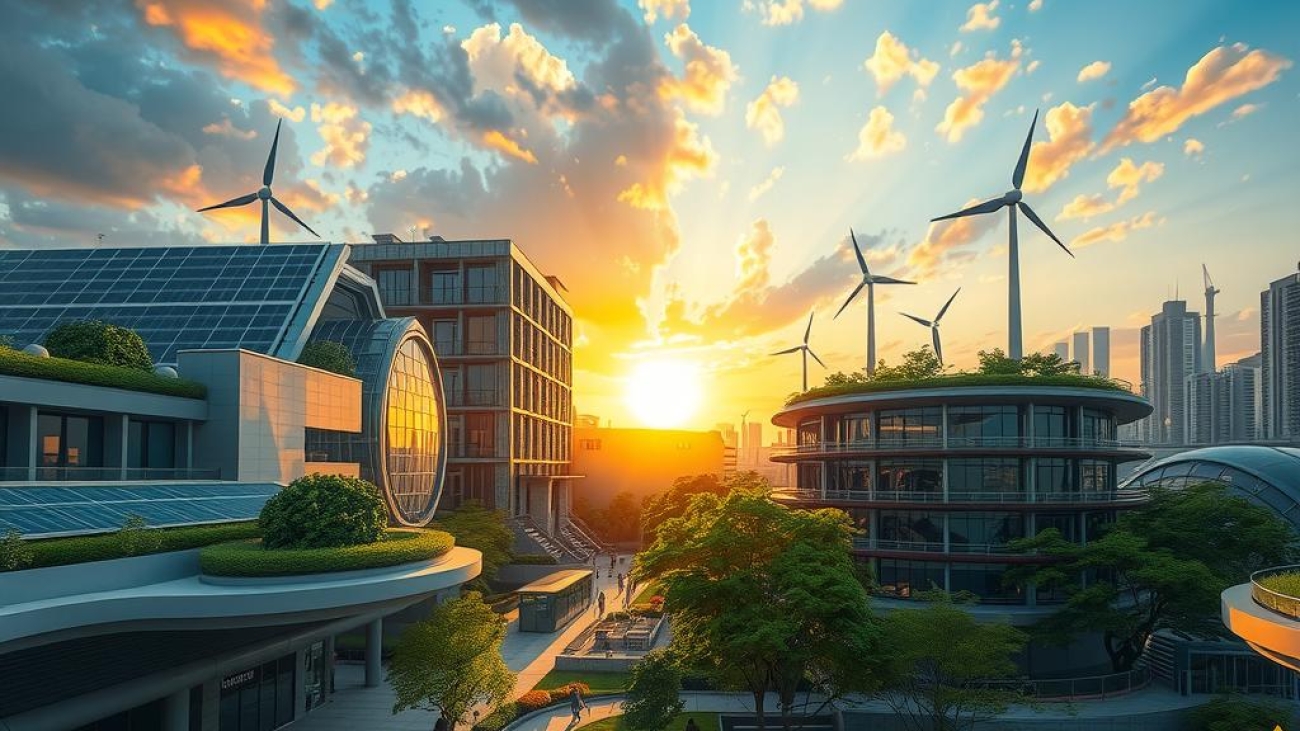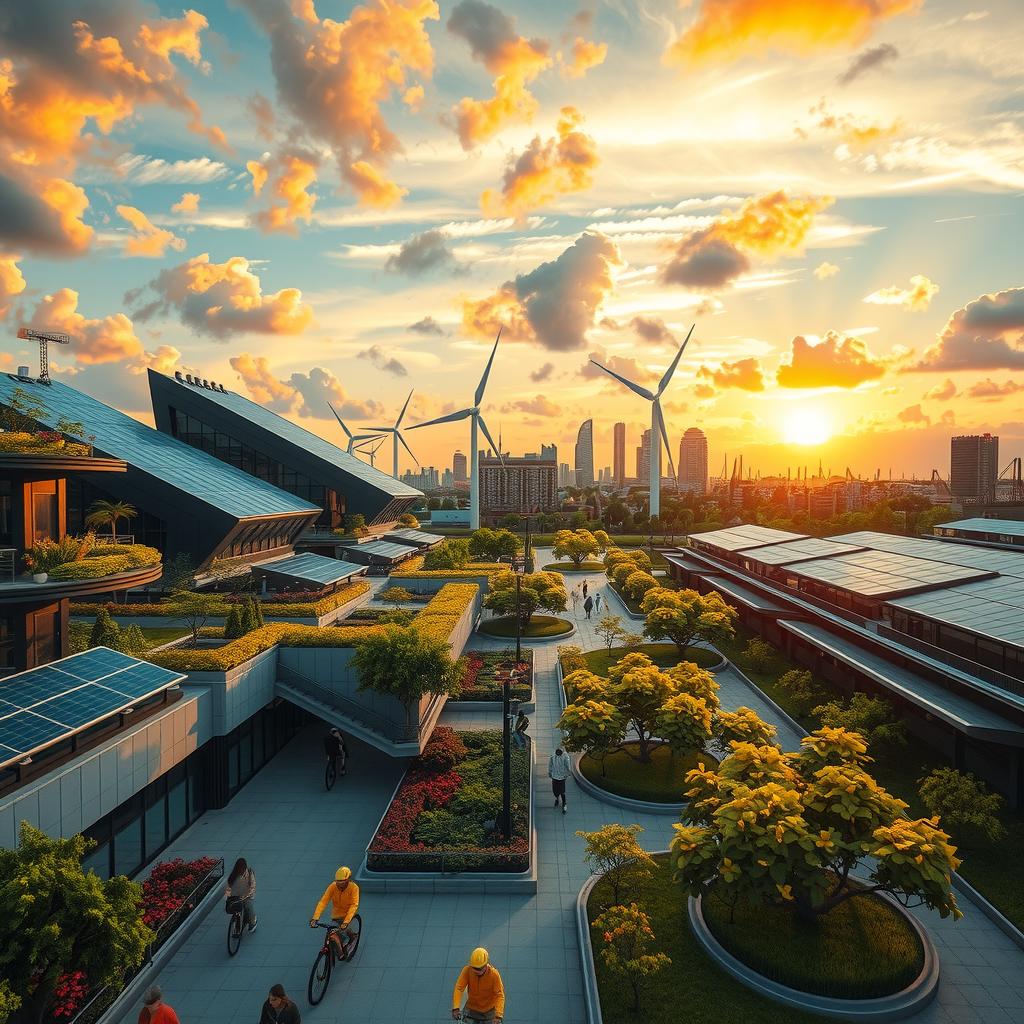As the world grapples with the ever-increasing effects of climate change, the travel industry is faced with a pressing challenge: how to adapt and mitigate the impact on tourist destinations and the decision-making process of travelers. The climate change phenomenon is undeniably reshaping the landscape of global tourism, compelling both travelers and industry stakeholders to redefine their approach to travel choices.
The impacts of climate change on travel are multifaceted and far-reaching. Rising sea levels, for instance, threaten coastal destinations, while extreme weather events can disrupt transportation and infrastructure, leading to cancellations and disruptions. Moreover, ecosystem shifts driven by climate change can dramatically alter the appeal and accessibility of certain tourist hotspots, forcing travelers to reconsider their travel choices.
In this context, the concept of climate-resilient destinations has gained traction, as travelers seek out locations that are better equipped to withstand the effects of a changing climate. Marine protected areas and low-carbon cities are becoming increasingly attractive, as they offer a more sustainable and environmentally-friendly approach to tourism. Travelers are also becoming more conscious of their carbon footprint, leading to a greater emphasis on eco-tourism and low-impact transportation options.
As the tourism industry grapples with these challenges, it is crucial for both travelers and industry players to embrace a proactive and collaborative approach to address the impact of climate change on travel choices. By staying informed about the latest developments in climate-resilient destinations, travelers can make more informed decisions that align with their values and environmental concerns.
Overall, the intersection of climate change and travel choices presents a complex and multifaceted challenge, but one that can be navigated with foresight, innovation, and a commitment to sustainable tourism practices. As the world continues to evolve, the travel industry must adapt and lead the way in mitigating the impact of climate change on our cherished tourist destinations.
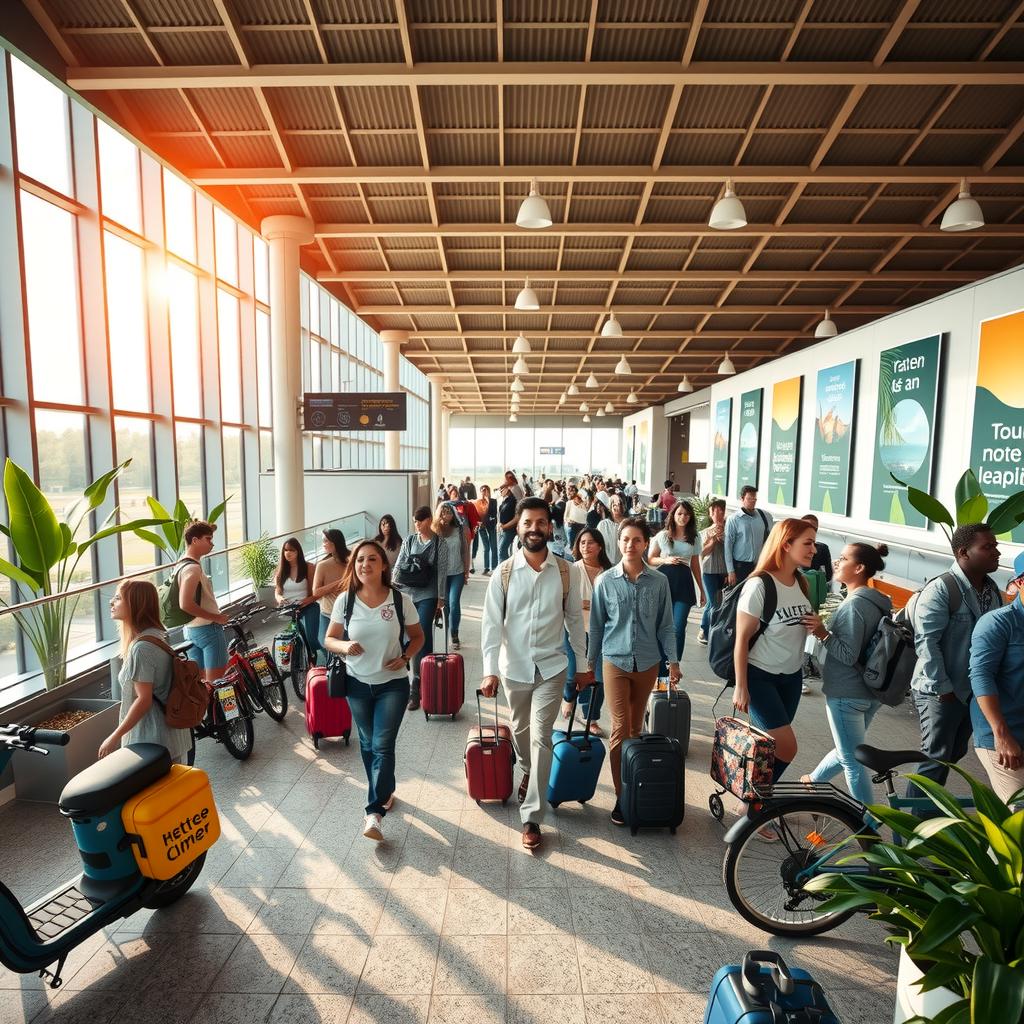
Key Points:
-
Changing Travel Destinations: Climate change is altering the conditions of many popular tourist destinations, making them less appealing or even uninhabitable for visitors. Travelers may need to consider new, more climate-resilient locations for their vacations.
-
Extreme Weather Impacts: Increasingly frequent and severe extreme weather events, such as hurricanes, floods, and heatwaves, can disrupt travel plans and threaten the safety of travelers. Choosing destinations less vulnerable to these hazards can be a priority.
-
Sea Level Rise Considerations: Rising sea levels due to climate change can submerge coastal areas, erode beaches, and damage infrastructure, affecting the viability of many seaside tourist destinations. Travelers may need to seek inland or elevated locations.
-
Ecosystem Shifts and Biodiversity Loss: Climate change is driving ecosystem shifts and biodiversity loss in many natural areas, which can negatively impact the appeal and experience of travel to these destinations. Preserving environmental integrity may become a key factor in travel decisions.
-
Sustainable Travel Choices: Travelers can help mitigate the negative impacts of climate change by choosing climate-resilient destinations, such as marine protected areas or low-carbon cities, which prioritize environmental protection and sustainable practices.
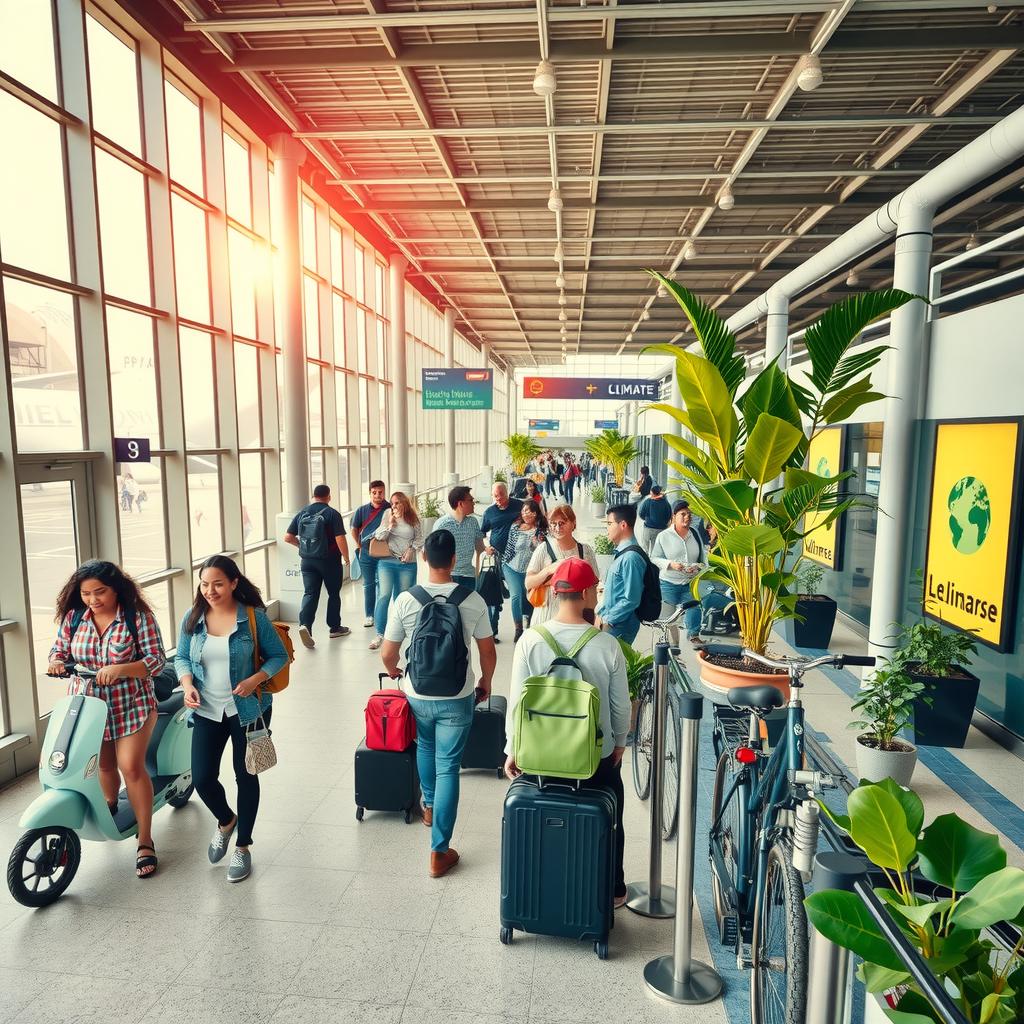
Unordered Directories Based on Background Information
Exploring Climate-Resilient Destinations
The impact of climate change on the travel industry has been a growing concern in recent years. As tourist destinations face the challenges of extreme weather, rising sea levels, and ecosystem shifts, travelers are increasingly seeking out destinations that are more climate-resilient. This has led to a shift in travel patterns, with many tourists opting for destinations that prioritize environmental protection and sustainable practices.
One of the key strategies for creating climate-resilient destinations is the establishment of marine protected areas. These protected zones help safeguard fragile ecosystems, such as coral reefs and mangrove forests, which are critical for maintaining the natural balance of coastal regions. By implementing strict regulations and conservation measures, these protected areas can help mitigate the effects of climate change and ensure the long-term viability of these important habitats.
Another approach to building climate-resilient travel destinations involves the development of low-carbon cities. These urban centers prioritize sustainable transportation, renewable energy, and green infrastructure, creating a more eco-friendly environment for both residents and visitors. By reducing their carbon footprint, these cities can help to mitigate the impact of climate change on the broader region, making them attractive destinations for environmentally conscious travelers.
Adapting Travel Choices to Climate Change
As the effects of climate change become more pronounced, travelers are also being asked to re-evaluate their own travel choices. This may involve opting for more sustainable modes of transportation, such as trains or electric vehicles, or choosing eco-friendly accommodations that minimize their environmental impact. Additionally, travelers can support local conservation efforts and environmental protection initiatives in the destinations they visit, helping to ensure the long-term viability of these places.
Overall, the challenges posed by climate change have led to a growing emphasis on the importance of climate-resilient destinations and sustainable travel choices. By embracing these principles, the travel industry can play a vital role in addressing the global issue of climate change and ensuring that future generations can continue to experience the wonders of the world.

Navigating Climate Change: Empowering Tourists to Make Sustainable Choices
Exploring Climate-Resilient Travel Destinations
As the global climate continues to undergo profound changes, the tourism industry faces unprecedented challenges. Tourists now must consider the climate adaptability of their chosen destinations, as extreme weather events, rising sea levels, and ecosystem shifts pose serious threats to the viability of many popular travel spots. By embracing a more proactive and informed approach, however, travelers can play a vital role in supporting the long-term sustainability of the tourism sector and the preservation of the natural environments they cherish.
When selecting a travel destination, it is crucial for tourists to prioritize climate-resilient locations that have demonstrated the capacity to withstand the impacts of climate change. This may involve destinations that have invested in robust infrastructure to mitigate the risks of extreme weather, such as strengthening coastal defenses or implementing effective disaster preparedness plans. Alternatively, travelers may opt for marine protected areas or low-carbon cities that have adopted comprehensive strategies to safeguard their natural ecosystems and reduce their environmental footprint.
Equally important is the consideration of a destination’s efforts to promote environmental protection and sustainable tourism practices. Destinations that have implemented initiatives to reduce their carbon emissions, conserve water resources, and minimize waste production are more likely to maintain their appeal and viability in the face of climate change. By choosing to visit these forward-thinking locations, tourists can send a powerful message to the industry, encouraging other destinations to follow suit and adopt more climate-conscious policies.
Embracing the Future of Sustainable Travel
As the impacts of climate change continue to reshape the tourism landscape, travelers must adopt a more adaptable and responsible mindset. By staying informed about the climate resilience of potential destinations and supporting those that prioritize environmental protection and sustainable practices, tourists can play a crucial role in shaping the future of the industry.
Climate Change and Sustainable Travel Choices
Marine Protected Areas: Safeguarding Ocean Ecosystems
The impacts of climate change on the world’s oceans have become increasingly evident, with rising sea levels, ocean warming, and ecosystem shifts posing significant threats to marine environments. In response, the establishment of marine protected areas (MPAs) has emerged as a crucial strategy for safeguarding the health and resilience of our oceans. These designated regions, such as national parks or conservation areas, aim to protect and restore fragile marine habitats, ensuring the preservation of biodiversity and the continued provision of vital ecosystem services.
MPAs can play a vital role in mitigating the effects of climate change on marine ecosystems. By restricting harmful human activities, such as overfishing and coastal development, these protected areas allow for the recovery and regeneration of marine life, enhancing the ability of these ecosystems to adapt to the challenges posed by a changing climate. Additionally, the restoration of habitats like coral reefs and mangrove forests can help buffer coastal communities from the impacts of rising sea levels and extreme weather events, making them more resilient to the effects of climate change.
For travelers seeking to minimize their environmental impact, visiting and supporting marine protected areas can be a meaningful way to contribute to the preservation of our oceans. By choosing to vacation in or near these protected areas, travelers can directly support the conservation efforts of local communities and organizations, while also immersing themselves in the unique natural wonders and biodiversity that these regions offer.
Low-Carbon Cities: Shaping Sustainable Urban Environments
As the world becomes increasingly urbanized, the need for cities to adopt sustainable practices has never been more pressing. Low-carbon cities have emerged as beacons of hope, demonstrating how urban areas can significantly reduce their greenhouse gas emissions and mitigate the effects of climate change.
These sustainable cities prioritize the integration of renewable energy sources, energy-efficient buildings, and robust public transportation systems. By promoting the use of electric vehicles, bike-sharing programs, and pedestrian-friendly infrastructure, low-carbon cities encourage residents and visitors to reduce their carbon footprint during their travels. Additionally, the preservation and expansion of urban green spaces, such as parks and urban forests, can help absorb carbon dioxide, improve air quality, and enhance the overall livability of these cities.
For travelers, choosing to visit and support low-carbon cities can be a powerful way to contribute to the global fight against climate change. By exploring these sustainable urban environments, travelers can witness firsthand the innovative approaches being taken to address the environmental challenges we face, and they can choose to participate in eco-friendly activities and experiences that align with their values.
Moreover, the adoption of sustainable practices in cities can have a ripple effect, inspiring other urban centers to follow suit and embrace a more environmentally conscious approach to development and travel. As more and more destinations strive to become low-carbon cities, travelers will have an ever-growing array of options for sustainable travel experiences that can help mitigate the impact of climate change on our planet.
Protect the Natural Environment
Embrace Sustainable Practices
Our natural environment is a precious resource that requires our utmost care and protection. As individuals, we have a responsibility to adopt sustainable practices that minimize our impact on the planet. This can be achieved through simple yet effective actions, such as reducing our carbon footprint, conserving energy and water, and properly disposing of waste. By making eco-friendly choices in our daily lives, we can contribute to the long-term preservation of our natural habitats and ecosystems.
One effective way to protect the environment is by embracing renewable energy sources. Transitioning to solar, wind, or geothermal power not only reduces our reliance on fossil fuels but also helps mitigate the effects of climate change. Additionally, we can implement energy-efficient measures in our homes and workplaces, such as upgrading to LED lighting, installing insulation, and using energy-efficient appliances. These small steps can have a significant impact on our carbon footprint and our collective effort to safeguard the environment.
Water conservation is another crucial aspect of environmental protection. By adopting water-saving practices, such as taking shorter showers, fixing leaks, and using water-efficient appliances, we can help preserve this precious resource. Furthermore, we can support the expansion of green spaces and the protection of natural habitats, which play a vital role in the water cycle and maintain the balance of our ecosystems.
Promote Sustainable Tourism
The tourism industry has a significant impact on the environment, and it is essential that we promote sustainable tourism practices to minimize our environmental footprint. Travelers can make conscious choices to support climate-resilient destinations, marine protected areas, and low-carbon cities that prioritize environmental protection and sustainable development.
When planning trips, travelers should research and select destinations that have implemented eco-friendly policies and initiatives. This may include destinations that have invested in renewable energy, sustainable waste management, or the preservation of local ecosystems. By choosing these types of destinations, travelers can contribute to the protection of the natural environment and support the local communities that rely on tourism as a source of income.
Moreover, travelers can adopt sustainable travel habits, such as using public transportation, reducing single-use plastics, and supporting local businesses that prioritize environmental sustainability. These actions not only reduce the environmental impact of travel but also promote a more authentic and enriching travel experience.
Foster Environmental Stewardship
Ultimately, the protection of the natural environment requires a collective effort from individuals, communities, and governments. By fostering a culture of environmental stewardship, we can inspire others to join the cause and collectively work towards a more sustainable future.
Through education and awareness campaigns, we can empower individuals to make informed choices and become active participants in environmental conservation. Schools, community organizations, and local governments can play a crucial role in this process by providing resources, programs, and initiatives that promote environmental literacy and encourage sustainable practices.
By working together and embracing our role as caretakers of the planet, we can ensure that our natural environments remain healthy and vibrant for generations to come. The protection of the natural environment is not only a responsibility but also an opportunity to create a more sustainable and resilient world for all.
The Impact of Climate Change on Travel Behavior
Destination Shifts and Changing Tourist Patterns
As the planet grapples with the escalating effects of climate change, the travel industry is facing significant transformations in tourist behavior and destination preferences. The rise in global temperatures, shifting weather patterns, and the increasing prevalence of extreme weather events are all factors that are shaping how and where people choose to travel.
One of the most notable impacts of climate change on travel behavior is the shift in destination choices. Travelers are becoming increasingly aware of the risks associated with certain destinations, such as the threat of rising sea levels, the increased frequency of natural disasters, and the degradation of natural ecosystems. As a result, many are opting to explore destinations that are perceived as more resilient to the effects of climate change, such as inland or high-altitude regions, or those that have taken proactive measures to mitigate the impacts of climate change.
The growing interest in climate-resilient destinations has led to the development of new tourism products and services tailored to this emerging market. Destinations are investing in infrastructure and public services that prioritize environmental sustainability and disaster preparedness, while tour operators are offering low-carbon travel packages and marine protected areas that safeguard fragile ecosystems.
Changing Travel Patterns and Sustainability Considerations
In addition to destination shifts, climate change is also influencing overall travel patterns and behaviors. Travelers are becoming more conscious of their environmental footprint and are seeking out ways to reduce their carbon emissions during their journeys. This has led to an increased demand for low-carbon transportation options, such as high-speed rail, electric vehicles, and biofuel-powered aircraft.
Furthermore, travelers are also more mindful of the environmental impact of their activities at their destinations. They are seeking out eco-friendly accommodations, supporting local businesses that prioritize environmental protection, and engaging in activities that minimize their disruption to fragile ecosystems.
Challenges and Opportunities for the Travel Industry
The travel industry is facing significant challenges in adapting to the changing landscape of climate change. Destinations must invest in resilient infrastructure, diversify their tourism offerings, and educate travelers on sustainable practices. Tour operators must rethink their business models to align with the evolving preferences of climate-conscious travelers.
However, these challenges also present opportunities for the industry to innovate and lead the way in sustainable tourism. By embracing climate-resilient strategies and low-carbon solutions, the travel industry can not only minimize its environmental impact but also position itself as a key player in the global effort to combat climate change.
The Future of Travel in a Changing Climate
As the effects of climate change continue to unfold, the travel industry must adapt and evolve to meet the changing needs and expectations of travelers. By prioritizing sustainability, investing in resilient infrastructure, and offering innovative travel experiences, the industry can play a crucial role in shaping a more environmentally responsible and climate-resilient future for global tourism.
Adapting to Ecosystem Shifts and Natural Disaster Risks
The impacts of climate change on travel behavior are not limited to destination choices and overall travel patterns. The increasing frequency and intensity of natural disasters, such as hurricanes, wildfires, and floods, are also forcing travelers to reconsider their plans and adapt their behavior accordingly.
Destinations that were once popular tourist hotspots may become less accessible or even off-limits due to the risk of natural disasters. Travelers are now more likely to research the disaster preparedness and emergency response capabilities of a destination before booking their trips. This has led to a growing demand for real-time information and transparent communication from tourism authorities and service providers.
Furthermore, the shifting of ecosystems due to climate change is also affecting travel experiences. Iconic natural wonders, such as coral reefs, glaciers, and wildlife habitats, are undergoing dramatic changes that can alter or even limit the activities and experiences available to visitors. Travelers are increasingly seeking out destinations that prioritize the conservation and restoration of these fragile environments.
The Role of Policymakers and Industry Stakeholders
Addressing the complex challenges posed by climate change in the travel industry requires a collaborative effort from policymakers, industry stakeholders, and travelers themselves. Governments must enact policies and regulations that incentivize sustainable tourism practices, promote the development of climate-resilient infrastructure, and support the transition to low-carbon transportation options.
Industry stakeholders, such as tour operators, accommodation providers, and transportation companies, must also take a proactive approach to mitigating their environmental impact and adapting to the changing landscape of travel. This may involve investments in renewable
Climate Change and the Impact on the Natural Environment
The Changing Face of Landscapes
The impact of climate change on the natural environment is undeniable. As global temperatures rise and extreme weather events become more frequent, the landscapes we have grown accustomed to are undergoing significant transformations. Climate change has led to the melting of glaciers, the shifting of ecosystems, and the loss of biodiversity, all of which have profound implications for our travel choices and the tourist destinations we can enjoy.
The retreat of glaciers in many parts of the world is a stark reminder of the scale of the environmental changes we are facing. As these natural wonders disappear, they take with them the unique landscapes and habitats that have defined these regions for centuries. This not only impacts the local ecosystems but also the travel experiences that many tourists have come to expect. Extreme weather events, such as hurricanes, wildfires, and droughts, are also becoming more prevalent, disrupting the availability and accessibility of popular travel destinations.
Shifts in Ecosystems and Biodiversity
In addition to the physical changes to landscapes, climate change is also driving significant shifts in the distribution and composition of ecosystems. As temperatures rise and precipitation patterns change, many species are being forced to adapt or relocate to more suitable habitats. This can lead to the loss of biodiversity and the disruption of delicate food webs, which can have cascading effects on the entire ecosystem.
For travelers, these ecosystem shifts can mean the disappearance of iconic species or the transformation of the natural environments they have come to enjoy. The loss of coral reefs due to rising sea levels and ocean acidification, for example, can significantly impact the appeal of marine protected areas and coastal travel destinations. Similarly, the decline of certain plant and animal species can alter the character of tourist destinations, diminishing the overall travel experience.
Adapting to a Changing World
As the impacts of climate change continue to unfold, the tourism industry and travelers must adapt to this new reality. Climate-resilient destinations that are better equipped to withstand the effects of environmental changes are likely to become more attractive, while low-carbon cities that prioritize environmental protection may emerge as preferred travel choices.
The tourism industry will need to work closely with environmental experts and policymakers to develop strategies that mitigate the negative impacts of climate change on the natural environment. This may involve investments in sustainable infrastructure, the promotion of eco-tourism, and the creation of marine protected areas to safeguard vulnerable ecosystems. By embracing these environmental initiatives, the tourism industry can help to preserve the natural wonders that draw travelers from around the world.
Sustainable Tourism Strategy
Embracing Sustainable Development in the Tourism Industry
The tourism industry, a key driver of economic growth and development, faces the pressing challenge of adapting to the realities of climate change. As the world grapples with the far-reaching impacts of a warming planet, the tourism sector must take proactive measures to ensure its long-term sustainability. This comprehensive strategy outlines how the industry can embrace sustainable development practices to mitigate and adapt to the effects of climate change, ultimately positioning the tourism sector as a leader in the global transition towards a more resilient and environmentally-conscious future.
Reducing the Carbon Footprint of Tourism
At the heart of the sustainable tourism strategy lies the imperative to reduce the industry’s carbon footprint. Tourism-related activities, from transportation to accommodation, contribute significantly to global greenhouse gas emissions. To address this challenge, the strategy proposes a multifaceted approach that encourages the adoption of renewable energy sources, the implementation of energy-efficient technologies, and the promotion of low-carbon transportation options. By incentivizing the use of electric vehicles, biofuels, and public transit, the industry can significantly lower its carbon emissions and contribute to the broader global effort to mitigate climate change.
Fostering Climate-Resilient Destinations
As the impacts of climate change become increasingly evident, the strategy emphasizes the importance of building climate-resilient tourist destinations. Rising sea levels, extreme weather events, and ecosystem shifts pose existential threats to many popular tourist hotspots. To safeguard these destinations, the strategy advocates for the implementation of robust disaster preparedness plans, the development of resilient infrastructure, and the protection of fragile natural environments. This includes the establishment of marine protected areas, the restoration of coral reefs, and the promotion of sustainable land-use practices that preserve the integrity of local ecosystems.
Empowering Local Communities
Sustainable tourism cannot be achieved without the active participation and empowerment of local communities. The strategy emphasizes the importance of engaging with host communities, respecting their cultural heritage, and ensuring that the benefits of tourism are equitably distributed. By fostering partnerships with local stakeholders, the industry can foster a sense of ownership and stewardship, driving the development of tourism models that are both environmentally and socially responsible.
Fostering Sustainable Consumption and Production
The final pillar of the sustainable tourism strategy focuses on promoting sustainable consumption and production patterns within the industry. This includes the adoption of circular economy principles, the reduction of waste, and the implementation of sustainable procurement practices. By encouraging the use of renewable and biodegradable materials, the strategy aims to minimize the environmental impact of tourism-related activities and contribute to the development of a more sustainable global economy.
Low-Carbon and Environmentally Friendly Travel Methods
Embracing Sustainable Travel Options
In the face of the pressing global challenge of climate change, it is crucial that we re-examine our travel habits and explore more environmentally friendly alternatives. Low-carbon and environmentally friendly travel methods offer a promising solution to reduce our carbon footprint and mitigate the impact of tourism on the natural world.
One of the most significant contributors to greenhouse gas emissions is the transportation sector, with air travel being a particularly energy-intensive mode. To address this, travelers can opt for low-carbon modes of transportation, such as trains, buses, or electric vehicles, which produce significantly lower emissions compared to traditional gasoline-powered cars or airplanes. High-speed rail networks, for instance, have become increasingly prevalent in many regions, providing a comfortable and efficient alternative to short-haul flights. Additionally, the rise of electric vehicles, coupled with the expansion of charging infrastructure, has made it easier for travelers to reduce their carbon footprint while on the road.
Beyond the mode of transportation, environmentally friendly travel also encompasses a wider range of sustainable practices. This includes seeking out accommodations that prioritize eco-friendly practices, such as the use of renewable energy, water conservation, and waste management. Many hotels and resorts are now adopting these green initiatives, providing travelers with the opportunity to reduce their environmental impact without compromising on comfort or experience.
Furthermore, low-carbon and environmentally friendly travel can extend to the choice of travel destinations. Travelers can opt for destinations that have implemented sustainable tourism practices, such as the development of climate-resilient infrastructure, the protection of marine protected areas, and the promotion of low-carbon cities. These destinations often prioritize the preservation of local ecosystems and the well-being of host communities, ensuring that the tourism industry can thrive in harmony with the natural environment.
By embracing low-carbon and environmentally friendly travel methods, travelers can play a vital role in the global effort to address climate change. Through conscious choices, individuals can reduce their carbon footprint, support the transition to a more sustainable tourism industry, and contribute to the preservation of our planet’s delicate ecosystems. As the awareness and demand for sustainable travel options continue to grow, the travel industry is poised to undergo a profound transformation, paving the way for a more environmentally responsible and resilient future.
Sustainable Accommodation and Destination Choices
In addition to the mode of transportation, the choice of accommodation and travel destinations can have a significant impact on the environmental footprint of a trip. Environmentally friendly travel extends beyond just the means of getting to a destination, as it also encompasses the selection of accommodations and destinations that prioritize sustainability and eco-friendly practices.
When it comes to accommodation, travelers can seek out hotels, resorts, and other lodging options that have implemented green initiatives. These may include the use of renewable energy sources, such as solar or wind power, as well as water conservation measures, efficient waste management, and the incorporation of locally sourced and organic materials. By choosing these environmentally friendly accommodations, travelers can ensure that their stay has a minimal impact on the local environment.
Similarly, the choice of travel destination can also play a crucial role in reducing the environmental impact of a trip. Climate-resilient destinations are those that have taken proactive steps to prepare for the effects of climate change, such as the development of infrastructure that can withstand extreme weather events or the protection of marine protected areas that safeguard fragile coastal ecosystems. These destinations often prioritize the preservation of natural habitats, the promotion of low-carbon transportation options, and the engagement of local communities in sustainable tourism practices.
By selecting environmentally friendly accommodations and climate-resilient destinations, travelers can contribute to the larger effort to promote sustainable tourism and mitigate the negative impacts of the industry on the environment. This not only reduces the individual traveler’s carbon footprint but also supports the development of a more responsible and resilient tourism industry that can adapt to the challenges posed by climate change.
As the demand for sustainable travel options continues to grow, the travel industry is increasingly responding with innovative solutions and eco-friendly initiatives. By embracing these low-carbon and environmentally friendly travel methods, travelers can make a meaningful difference in the fight against climate change while enjoying enriching and responsible travel experiences.
Climate change is significantly altering the conditions of many popular tourist destinations worldwide. Extreme weather events, rising sea levels, and ecosystem shifts are just a few of the challenges that travelers now face when planning their trips. However, individuals can mitigate the negative impacts of climate change on their travel decisions by choosing climate-resilient destinations, such as marine protected areas or low-carbon cities, thereby contributing to the protection of natural environments.
One of the primary ways climate change is affecting travel is through the increased frequency and intensity of extreme weather events. Travelers may find their plans disrupted by hurricanes, floods, or wildfires, which can damage infrastructure and make certain destinations inaccessible. By considering the climate resilience of a destination, travelers can better prepare for and adapt to these unpredictable conditions.
Another significant impact of climate change on travel is the rise in sea levels, which threatens coastal regions and islands that are popular tourist destinations. Travelers may need to rethink their plans to visit these areas, as they may become inundated or experience significant erosion and habitat loss. Choosing destinations that are less vulnerable to sea-level rise, such as inland or elevated areas, can help mitigate this risk.
Lastly, climate change is driving shifts in ecosystems, leading to the loss of biodiversity and changes in the natural landscapes that draw many travelers. Tourists may find that their favorite destinations no longer offer the same experiences or attractions they once did. By selecting destinations that are actively working to protect their natural environments, travelers can contribute to the preservation of these unique ecosystems.
## FAQs:
#### Q: How can travelers mitigate the negative impacts of climate change on their travel decisions?
A: Travelers can mitigate the negative impacts of climate change on their travel decisions by choosing climate-resilient destinations, such as marine protected areas or low-carbon cities. These types of destinations are better equipped to withstand the challenges posed by extreme weather events, rising sea levels, and ecosystem shifts, helping travelers adapt to the changing conditions.
#### Q: What are some of the primary ways climate change is affecting travel?
A: Climate change is affecting travel in several key ways:
1. Increased frequency and intensity of extreme weather events, which can disrupt travel plans and damage infrastructure.
2. Rising sea levels, which threaten coastal regions and islands that are popular tourist destinations.
3. Ecosystem shifts, leading to the loss of biodiversity and changes in the natural landscapes that draw many travelers.
#### Q: How can travelers contribute to the protection of natural environments when making travel choices?
A: By selecting destinations that are actively working to protect their natural environments, such as marine protected areas or low-carbon cities, travelers can contribute to the preservation of unique ecosystems. These types of climate-resilient destinations are better equipped to mitigate the negative impacts of climate change, helping to safeguard the natural resources and experiences that draw many travelers in the first place.
